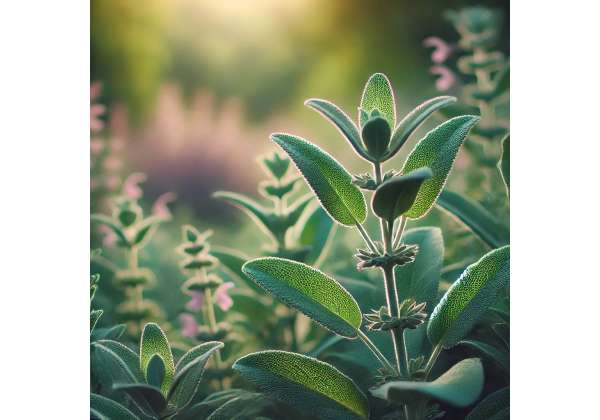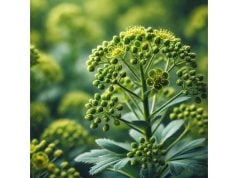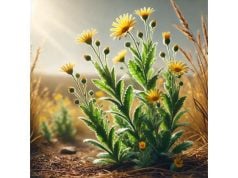
Garden sage is a timeless herb cherished not only for its culinary versatility but also for its potent medicinal properties and rich history in traditional herbal medicine. Known scientifically as Salvia officinalis, garden sage has been used for centuries to enhance flavor in cooking, support cognitive function, and provide natural antioxidant and anti-inflammatory benefits. Its aromatic leaves, bursting with essential oils, make it a staple in kitchens and gardens worldwide. This comprehensive guide delves into garden sage’s botanical profile, phytochemical composition, diverse health benefits, safe usage recommendations, and the latest scientific studies, offering you all the essential information to harness its potential responsibly.
Table of Contents
- Botanical Profile & Identification
- Phytochemistry & Active Compounds
- Garden Sage Benefits & Properties
- Garden Sage Uses & Safety
- Scientific Research & Significant Studies
- FAQ
Garden Sage: Botanical Profile & Identification
Garden sage (Salvia officinalis) is a perennial, woody herb in the Lamiaceae family, native to the Mediterranean region. Known for its silvery-green, velvety leaves and distinctive, aromatic flavor, this herb is a cornerstone of both culinary and medicinal traditions. Garden sage typically grows to about 60–80 centimeters in height, with a bushy habit that supports clusters of delicate, violet-blue flowers in late spring to early summer.
Taxonomy and Classification
- Family: Lamiaceae
- Genus: Salvia
- Species: Salvia officinalis
- Common Names: Garden sage, common sage, culinary sage
Morphological Characteristics
Garden sage is easily recognized by its:
- Leaves:
The leaves are oval, covered with fine hairs, and display a grayish-green color with slightly serrated edges. Their pungent aroma intensifies when crushed, releasing essential oils. - Flowers:
The flowers are arranged in whorls on spikes. Typically blue to violet in color, they add ornamental appeal and attract beneficial pollinators such as bees. - Stems and Growth Habit:
The stems are woody and sturdy, supporting a compact, bushy growth habit ideal for container gardening and ornamental landscapes.
Growth Conditions and Natural Habitat
Garden sage thrives in well-drained, slightly alkaline soil under full sun. Its Mediterranean origins mean it prefers hot, dry summers and mild, wet winters. The herb’s drought tolerance and low maintenance requirements make it a popular choice for xeriscaping and organic gardening. While it flourishes in warm climates, garden sage can also be cultivated in cooler regions with proper winter protection.
Cultivation and Propagation
Propagation is typically achieved through seed sowing in the spring or by taking semi-hardwood cuttings during the growing season. Regular pruning encourages a denser, more productive plant and helps prevent woody growth. Gardeners prize sage not only for its culinary and medicinal properties but also for its pest-repelling characteristics, making it a valuable companion plant in vegetable gardens.
Historical and Cultural Significance
For centuries, garden sage has symbolized wisdom and longevity. In ancient Rome, it was revered as a sacred herb and used in rituals to promote health and ward off evil. Medieval herbalists recommended sage for its healing properties, and today, it remains a staple in traditional medicine. Its enduring cultural importance is reflected in literature, folklore, and the continued popularity of sage tea and extracts in modern wellness practices.
Garden sage’s robust nature, coupled with its rich aromatic profile and historical legacy, makes it a remarkable herb that bridges the gap between culinary delight and natural medicine. Its diverse applications and ease of cultivation have secured its place as a favorite among gardeners, chefs, and herbalists worldwide.
Garden Sage: Phytochemistry & Active Compounds
The myriad benefits of garden sage are rooted in its complex phytochemical composition. Modern research has identified a range of bioactive compounds that work synergistically to provide its therapeutic, culinary, and cosmetic benefits. Below is an in-depth look at the key active compounds found in garden sage:
- Essential Oils
Garden sage is renowned for its rich essential oil content, which includes compounds such as thujone, cineole, camphor, borneol, and pinene.
- Thujone: Plays a significant role in the herb’s distinct aroma and has been studied for its potential neurological effects.
- Cineole: Known for its anti-inflammatory and antimicrobial properties, it contributes to respiratory health benefits.
- Camphor and Borneol: These compounds are noted for their analgesic and stimulating effects, making sage a popular remedy for muscle pain and headaches.
- Flavonoids
Sage contains a variety of flavonoids, including luteolin, apigenin, and hispidulin.
- These antioxidants help neutralize free radicals, reducing oxidative stress and inflammation.
- Their presence supports cardiovascular health and may contribute to cognitive enhancement.
- Phenolic Acids
Rosmarinic acid is one of the most significant phenolic acids in garden sage.
- It offers robust antioxidant protection, reduces inflammation, and has been linked to anti-allergic properties.
- Rosmarinic acid is also beneficial for skin health, helping to mitigate damage from environmental stressors.
- Triterpenoids
Compounds such as ursolic acid are present in garden sage and exhibit anti-inflammatory, antimicrobial, and anticancer properties.
- Ursolic acid has been researched for its ability to promote muscle growth and improve metabolic health, making it a subject of interest in sports nutrition.
- Diterpenoids
Sage also contains diterpenoids that contribute to its overall bioactivity, supporting various cellular processes and modulating immune responses. - Coumarins
Although present in smaller amounts, coumarins contribute to the herb’s complex flavor and may exert mild anticoagulant effects.
- They also enhance the overall antioxidant capacity of sage.
- Minerals and Vitamins
Garden sage is a source of vitamins A, C, and K, as well as essential minerals like calcium, potassium, and magnesium.
- These micronutrients are vital for maintaining bone health, immune function, and overall metabolic balance.
The interplay of these compounds not only explains the multifaceted benefits of garden sage but also highlights its potential as a natural remedy. While each component contributes uniquely, their combined actions create a powerful synergistic effect that supports digestive health, cognitive function, anti-aging benefits, and much more.
Garden Sage: Benefits & Properties
Garden sage is much more than a culinary herb—it is a powerhouse of natural compounds that support health in diverse ways. The benefits of garden sage are well-documented in traditional medicine and are increasingly supported by modern research. Here are the key health and therapeutic benefits associated with this remarkable herb:
Key Health and Therapeutic Benefits
- Antioxidant Protection:
The flavonoids, phenolic acids, and essential oils in garden sage work together to provide robust antioxidant protection. These compounds help neutralize free radicals, thereby reducing oxidative stress and lowering the risk of chronic diseases such as cardiovascular disorders and neurodegenerative conditions. - Anti-Inflammatory Effects:
Garden sage’s bioactive constituents, including cineole and ursolic acid, exhibit significant anti-inflammatory properties. Regular use may help reduce inflammation associated with arthritis, muscle pain, and inflammatory skin conditions, supporting overall wellness. - Cognitive Support and Memory Enhancement:
Traditionally, sage has been used to boost memory and cognitive function. Modern studies suggest that its essential oils may enhance brain activity and improve concentration, making it a popular ingredient in natural nootropic formulations. - Digestive Aid:
The bitter compounds in garden sage stimulate the production of digestive enzymes, promoting efficient digestion and alleviating symptoms such as bloating and indigestion. Its antimicrobial properties also help maintain a healthy balance of gut flora. - Antimicrobial and Antiviral Activity:
The essential oils in sage possess potent antimicrobial and antiviral properties, making the herb a natural remedy for respiratory infections, sore throats, and minor wounds. It is often used in herbal teas and gargles for its soothing effects. - Hormonal Balance:
Some studies indicate that garden sage may help modulate hormonal activity, particularly in menopausal women. It is traditionally used to alleviate hot flashes and mood swings, contributing to overall hormonal balance. - Skin Health and Cosmetic Benefits:
When applied topically, sage extracts can help reduce acne, soothe irritated skin, and promote a clearer complexion. Its antimicrobial and anti-inflammatory properties support wound healing and reduce the appearance of blemishes and fine lines.
Additional Therapeutic Properties
- Anticancer Potential:
Preliminary research suggests that certain compounds in garden sage may inhibit the growth of cancer cells, although more clinical studies are needed to confirm these effects. - Cardiovascular Support:
By reducing oxidative stress and inflammation, sage may support heart health and improve blood circulation. - Respiratory Benefits:
Sage’s essential oils are commonly used in steam inhalation therapies to relieve congestion and support respiratory health.
Mechanisms of Action
The multifaceted benefits of garden sage are driven by:
- Antioxidant activity that combats free radicals.
- Anti-inflammatory compounds that reduce cytokine production.
- Stimulation of digestive enzymes that improve nutrient absorption.
- Neuroprotective effects that enhance cognitive function.
- Antimicrobial actions that inhibit pathogenic microorganisms.
By incorporating garden sage into your daily routine, you can enjoy a holistic boost to your health—ranging from improved digestion and enhanced memory to healthier skin and a strengthened immune system.
Garden Sage: Uses & Safety Considerations
While garden sage is celebrated for its myriad benefits, it is important to use it safely and appropriately. This section outlines the practical applications of garden sage, recommended preparation methods, dosage guidelines, and safety precautions to ensure you maximize its benefits while minimizing potential risks.
Practical Applications
- Culinary Uses:
Garden sage is a classic culinary herb used to season meats, sauces, and soups. Its robust, earthy flavor pairs well with poultry, pork, and pasta dishes. Sage is also popular in stuffing and herbal blends such as herbes de Provence. - Herbal Teas and Infusions:
Sage tea is a time-honored remedy for digestive issues and sore throats. Steeping a few fresh or dried leaves in boiling water creates an infusion that may help alleviate inflammation and promote relaxation. - Medicinal Preparations:
Traditional herbal medicine employs garden sage in the form of tinctures, extracts, and compresses. A diluted tincture applied externally can help soothe muscle cramps, joint pain, and skin irritations. Internally, sage tea is sometimes used to ease menstrual discomfort and boost digestion. - Aromatherapy and Essential Oil Applications:
The essential oil of garden sage is widely used in aromatherapy. Diffusing a few drops can help improve mental clarity, reduce stress, and support respiratory health. When used topically, the oil must be diluted with a carrier oil to avoid skin irritation. - Cosmetic and Skincare Products:
Garden sage extract is incorporated into creams, serums, and facial masks due to its antioxidant and anti-inflammatory properties. It can help reduce signs of aging, improve skin tone, and soothe acne-prone skin.
Preparation Methods and Dosage Recommendations
- Culinary and Tea Preparations:
Use 1–2 teaspoons of dried sage leaves per cup of boiling water for tea. In cooking, a pinch or two of finely chopped fresh sage is typically sufficient to flavor dishes. - Tinctures and Extracts:
A standard tincture of garden sage is usually prepared with an alcohol base. For external use, dilute 10–15 drops in a tablespoon of carrier oil before applying to the skin. - Essential Oil Diffusion:
For aromatherapy, add 2–3 drops of sage essential oil to a diffuser containing about 100 ml of water. Always use high-quality, 100% pure essential oil for best results. - Topical Application:
Always perform a patch test before using any new skincare product containing sage extract. Use products as directed by the manufacturer or under the guidance of a healthcare professional.
Safety Concerns and Contraindications
- Thujone Content:
Garden sage contains thujone, a compound that in high doses can be neurotoxic. While culinary amounts are generally safe, concentrated extracts or excessive consumption may lead to adverse effects. - Pregnancy and Breastfeeding:
Due to potential hormonal effects and thujone toxicity, sage is not recommended for use during pregnancy or lactation. - Allergic Reactions:
Some individuals may experience skin irritation or allergic reactions. Always conduct a patch test before widespread topical application. - Drug Interactions:
Sage may interact with medications that affect the central nervous system or blood clotting. Consult a healthcare provider if you are on prescription medications. - Internal Use Caution:
Internal consumption of high doses of sage, especially concentrated extracts or essential oils, should be avoided. Stick to culinary or tea preparations in recommended amounts.
Best Practices for Safe Use
- Quality Assurance:
Purchase garden sage products from reputable sources to ensure purity and proper standardization of active compounds. - Moderation:
Use sage in moderation to avoid potential toxicity, particularly from thujone. Balance its intake with a varied diet. - Consultation:
Seek professional guidance when using garden sage for medicinal purposes, especially if you have pre-existing health conditions.
By following these guidelines, you can safely enjoy the diverse benefits of garden sage in your culinary, medicinal, and aromatic endeavors while minimizing any associated risks.
Garden Sage: Scientific Research & Significant Studies
Recent scientific studies have shed light on the various mechanisms by which garden sage exerts its beneficial effects. Below are several key studies that illustrate the herb’s potential across multiple health areas:
- Study on Cognitive Enhancement and Memory (2016)
Publication: Journal of Psychopharmacology
Study Name: “Effects of Salvia officinalis on Cognitive Performance in Healthy Adults”
Key Findings:
This randomized controlled trial evaluated the impact of garden sage extract on cognitive performance. Participants who consumed a standardized sage extract showed statistically significant improvements in memory, attention, and information processing speed compared to a placebo group. The study attributes these benefits to sage’s cholinergic activity and antioxidant properties, which protect neuronal integrity. The findings support the traditional use of sage as a natural nootropic and provide a promising basis for further research into its role in age-related cognitive decline. - Investigation of Antimicrobial and Anti-inflammatory Properties (2018)
Publication: Phytotherapy Research
Study Name: “Antimicrobial and Anti-Inflammatory Activities of Salvia officinalis Extracts”
Key Findings:
Researchers examined various extracts of garden sage for their antimicrobial efficacy against common pathogens and their ability to reduce inflammatory markers in vitro. The results revealed that sage extracts inhibited the growth of several bacterial strains and significantly decreased the production of pro-inflammatory cytokines. These outcomes are primarily attributed to the presence of essential oils and flavonoids. This study provides scientific validation for the traditional use of sage in treating infections and inflammatory conditions, reinforcing its potential as a natural remedy in topical and internal applications. - Analysis of Antioxidant Capacity and Metabolic Effects (2020)
Publication: Journal of Agricultural and Food Chemistry
Study Name: “Antioxidant Activity and Metabolic Effects of Salvia officinalis in Animal Models”
Key Findings:
In this preclinical study, researchers assessed the antioxidant activity of garden sage and its impact on metabolic health in rodent models. The findings indicated that sage supplementation enhanced antioxidant enzyme activity and improved markers of lipid metabolism, suggesting a protective effect against oxidative stress and metabolic syndrome. These promising results pave the way for clinical trials investigating the long-term benefits of sage in human metabolic health and underscore its potential in preventive nutrition.
Collectively, these studies provide robust evidence supporting the multifaceted benefits of garden sage. They highlight its role in cognitive enhancement, antimicrobial and anti-inflammatory actions, and metabolic regulation. Continued research in these areas will help optimize dosage, formulation, and safe usage guidelines for both medicinal and culinary applications.
FAQ
What are the primary benefits of garden sage?
Garden sage is renowned for its antioxidant, anti-inflammatory, and cognitive-enhancing properties. It is traditionally used to improve memory, aid digestion, and support overall immune health, making it a versatile herb in both culinary and medicinal applications.
How is garden sage typically used in cooking?
Garden sage is a popular culinary herb used to season meats, soups, and sauces. Its robust, earthy flavor is ideal for dishes like stuffing and stews. Sage is also used in herbal teas and infused oils, though it should be used in moderation.
Can garden sage be used safely on the skin?
Yes, garden sage extracts are used in skincare products for their antioxidant and anti-inflammatory benefits. However, they must be properly diluted, and a patch test should be performed to prevent allergic reactions or irritation.
Are there any precautions for internal use of garden sage?
Due to the presence of thujone, high doses of garden sage—especially concentrated extracts—should not be ingested. Culinary and tea preparations in moderate amounts are generally safe, but internal use of potent formulations is not recommended.
Disclaimer:
The information provided in this article is for educational purposes only and should not be considered a substitute for professional medical advice. Always consult with a healthcare provider before using any herbal products or making changes to your wellness regimen.
Share this article on Facebook, X (formerly Twitter), or your preferred social media platform to help spread the word about the natural benefits and safe use of garden sage!










